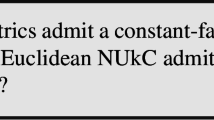Abstract
This paper deals with the average-case-analysis of the number of pivot steps required by the simplex method. It generalizes results of Borgwardt (who worked under the assumpution of the rotation-symmetry-model) for the shadow-vertex-algorithm to so-called cylindric distributions. Simultaneously it allows to analyze an extended dimension-by-dimension-algorithm, which solves linear programing problems with arbitrary capacity bounds \(b\) in the restrictions \(Ax\le b\), whereas the model used by Borgwardt required strictly positive right hand sides \(b\). These extensions are achieved by solving a problem of stochastic geometry closely related to famous results of Renyi and Sulanke, namely: assume that \(a_1,\ldots ,a_m\) are uniformly distributed in a cylinder. How many facets of \({{\mathrm{conv}}}(a_1,\ldots ,a_m,0)\) will be intersected by a two-dimensional shadow plane along the axis of the cylinder? The consequence of these investigations is that the upper bounds of Borgwardt (under his original model) still apply when we accept distributions with arbitrary right hand sides.



Similar content being viewed by others
Notes
Here, \(1\!\!1\) is the vector containing \(1\) in each component.
We should mention that this claim does not hold for the start-simplex and the optimal-simplex in the simplex path because for these two simplices only one boundary \((n-1)\)-dimensional simplex is intersected. But this fact is not essential for our purpose.
This intersection point exists in our model with probability \(1\).
See Göhl (2013) for details.
Compare Borgwardt (2007).
See Göhl (2013) for a proof.
See Göhl (2013) for a proof.
See Göhl (2013) for details.
See Göhl (2013) for a proof.
See Göhl (2013) for a proof.
References
Borgwardt KH (1977) Untersuchungen zur Asymptotik der mittleren Schrittzahl von Simplexverfahren in der linearen Optimierung. Dissertation, Universität Kaiserslautern
Borgwardt KH (1982) The average number of pivot steps required by the simplex-method is polynomial. Z Oper Res 26:157–177
Borgwardt KH (1987) The simplex method: a probabilistic analysis. Springer, Berlin
Borgwardt KH (1999) A sharp upper bound for the expected number of shadow-vertices in the rotation-symmetry-model—quadratic in the smaller and sublinear in the larger dimension of the LP. Math Oper Res 24(4):925–984
Borgwardt KH (2007) Average-case analysis of the double description method and the beneath–beyond algorithm. Discrete Comput Geom 37:175–204
Dantzig GB (1951) Maximization of a linear function of variables subject to linear inequalities. Activity analysis of production and allocation, Cowles Commission Monograph 13. Wiley, New York, pp 339–347
Dantzig GB (1963) Linear programming and extensions. Princeton University Press, Princeton
Göhl M (2013) Der durchschnittliche Rechenaufwand des Simplexverfahrens unter einem verallgemeinerten Rotationssymmetriemodell. Dissertation, Universität Augsburg.
Höfner G (1995) Lineare Optimierung mit dem Schatteneckenalgorithmus: Untersuchungen zum mittleren Rechenaufwand und Entartungsverhalten. Dissertation, Universität Augsburg.
Klee V, Minty GJ (1972) How good is the simplex algorithm? In: O Shisha (ed) Inequalities III. Academic Press, New York, pp 159–175
Renyi A, Sulanke R (1963) Über die konvexe Hülle von \(n\) zufällig gewählten Punkten. Z Wahrscheinlichkeitsth 2:75–84
Author information
Authors and Affiliations
Corresponding author
Rights and permissions
About this article
Cite this article
Göhl, M., Borgwardt, K.H. The average number of pivot steps of the simplex-algorithm based on a generalized rotation-symmetry-model. Math Meth Oper Res 80, 329–366 (2014). https://doi.org/10.1007/s00186-014-0483-8
Received:
Accepted:
Published:
Issue Date:
DOI: https://doi.org/10.1007/s00186-014-0483-8





